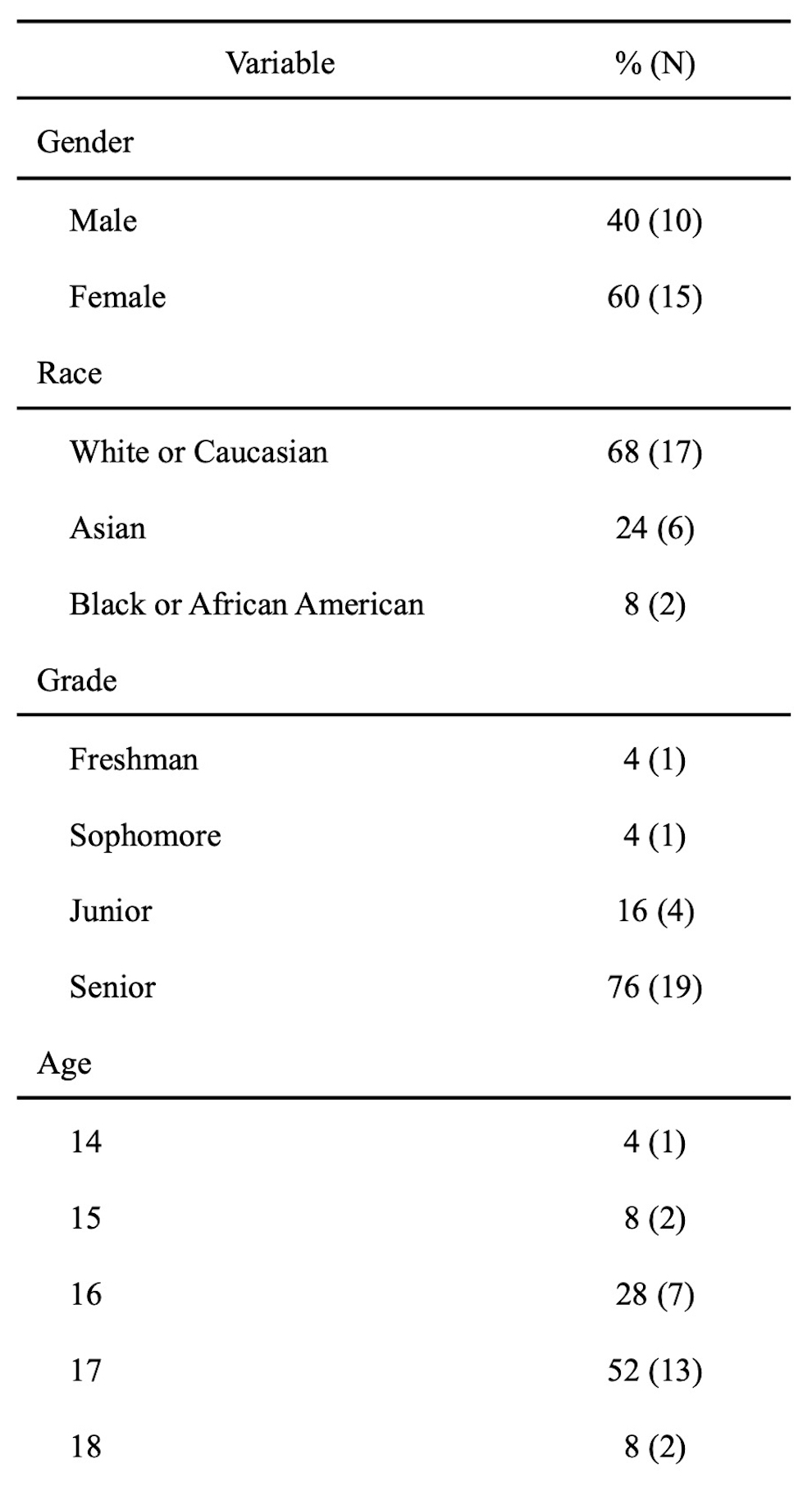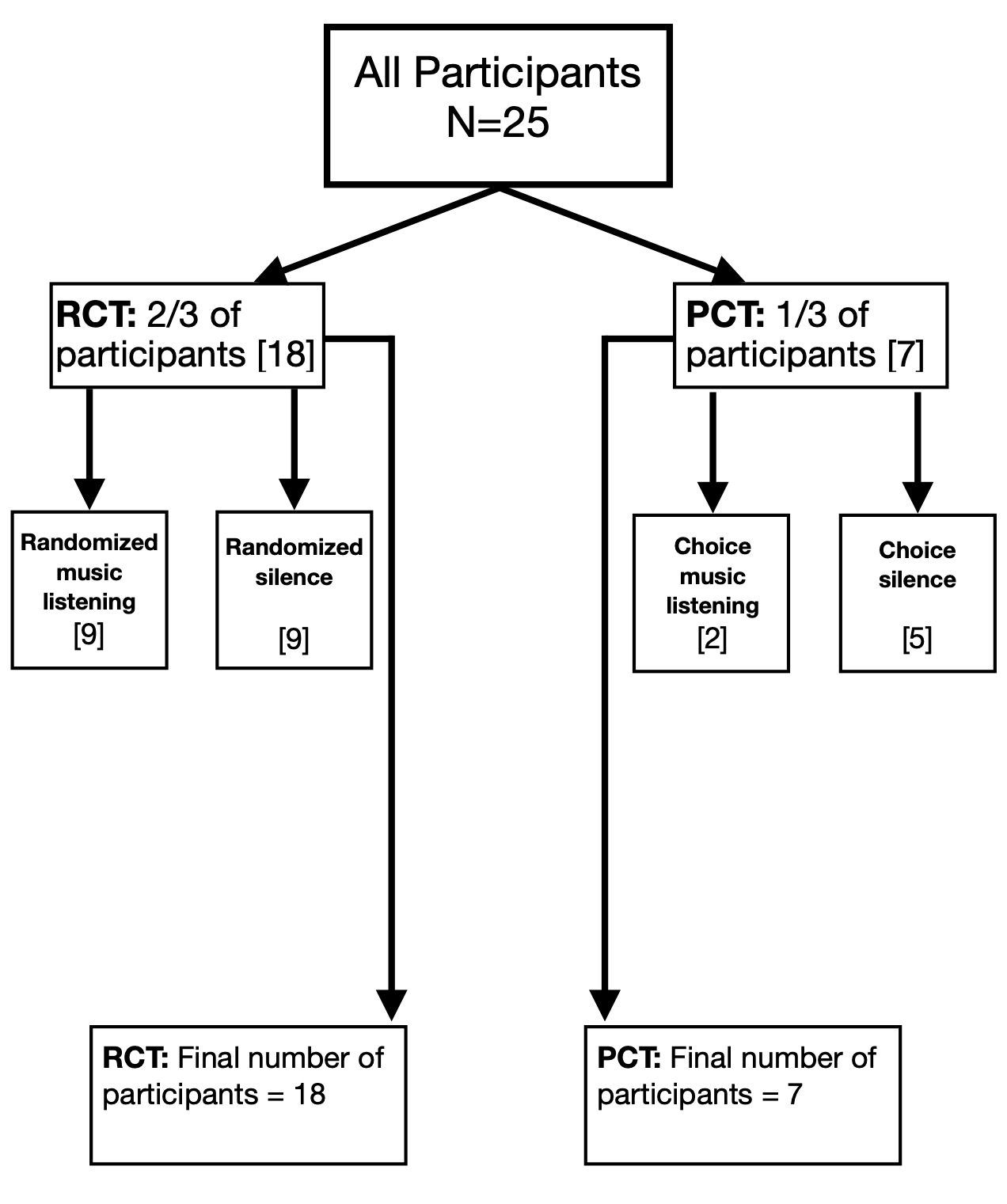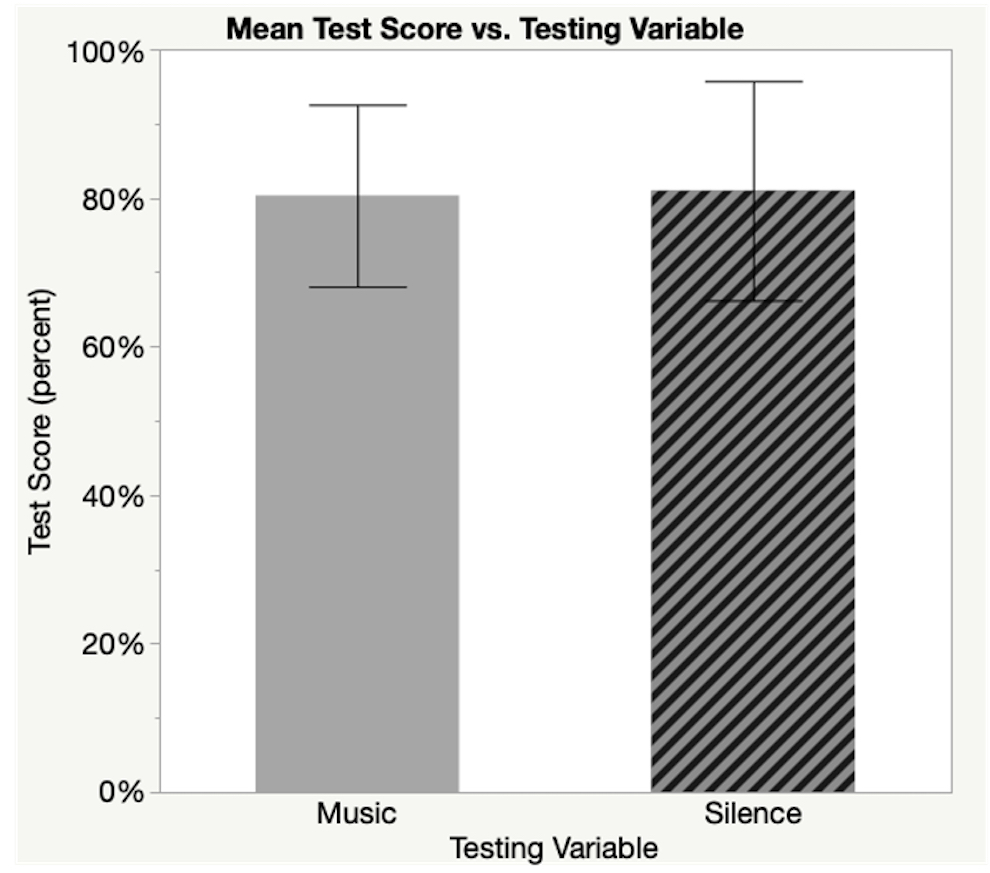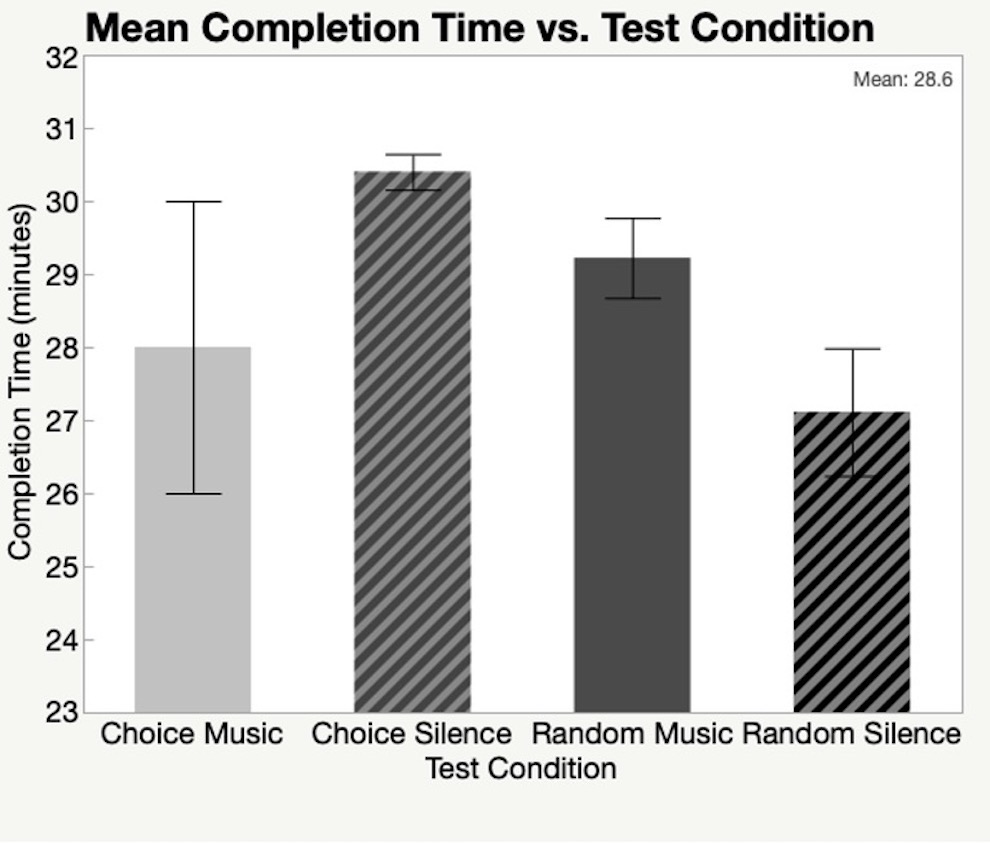The Effect of Background Music on Standardized Math Test Performance in High School Students
ABSTRACT
Many students listen to music while studying, often claiming that it helps them focus. However, studies have repeatedly shown that background music has negative, if any, effects on testing and studying. This study tested the effects of back-ground music on students’ standardized math test performance using ACT math questions. Twenty-five high school students were randomly assigned to test either with or without back-ground music or to choose between the two. ANOVAs found that higher average math grades were associated with higher test scores (p < .001). Background music had no significant effect on test performance (p > .9). Students accustomed to testing with music finished significantly faster than those who prefer to test in silence (p < .02). Test completion time was significantly different between the participants randomly as-signed to test in silence and the participants who chose to test in silence (p < .04). These results suggest that the effects of background music on test performance may be unique to an individual. Thus, further research is required to identify which individual traits may enable students to perform well with background music.
INTRODUCTION.
Research on the effect of background music on task performance ability dates back to the 1940s [1]. In the 80 years since music has become an unavoidable background sound just about anywhere a person might choose to work. The sheer ubiquity of background music creates a need to study its impact on individuals. That need is more pronounced given the vast and rapid increase in online schooling due to the COVID-19 pandemic.
Online school is an important tool to combat the risks of large, in-person gatherings, but it comes at the cost of exposing students to new opportunities for distraction due to the absence of a physically present teacher. As an online test feels much like studying at home, students may not think twice about listening to music as they do so. The effect of this practice raises important questions about the consequences of background music on students’ test performance.
It is important to pare the many possible confounding variables down to those that are applicable to a specific group of people. This study used high school students taught online during the COVID-19 pandemic. Despite the sudden growth in online school participation raised many questions about how students would be affected. Students’ increased autonomy in online school raises the question: how will their choice to test with or without music affect their performance?
Though it is commonplace for many students to study with background music [2], teachers tend to prohibit students from listening to music while they test. That is, they tend to prohibit it when they are physically present with students. When schools shifted online, many teachers adopted relaxed test procedures, especially regarding background music, as they simply lacked the power to enforce stricter rules.
Figure 1. The distribution of participants into the RCT and PCT. Two-thirds of participants (18) were assigned to the RCT and the remaining one-third (7) were assigned to the PCT [3].
In a controlled experiment with a standardized test, it is easier to see how background music affects students’ scores. This experiment featured a two-armed design [3] in which participants were divided with two-thirds assigned to the first arm and one-third assigned to the other. The first, the Randomized Control Trial (RCT), randomly assigned participants to test with background music or silence. It gathered general data about the population. The second arm, the Preference Control Trial (PCT), allowed participants to choose to test either with background music or silence. This simulated the autonomy students have in online school. Combined, these simulated a testing environment where it was possible to observe music’s effect on test performance and completion time and see how personal choice might play into that.
This study included two hypotheses. The first was that music would not affect test scores. Some studies have suggested that a learning curve may exist as far as working with background music [4], and others have shown that personal preference [5], [6] can affect how one performs tasks with it. However, studies looking broadly at the effects of background music on task performance tended to find that music was detrimental [7], [8] or at least ineffectual [9], [6] in helping test performance. The second hypothesis, therefore, was that participants in their preferred testing condition would perform better than those who were not. These participants were expected to be more comfortable in their self-designed setups. Without their familiar condition, other participants were not expected to perform as well.
MATERIALS AND METHODS.
Participants.
Participants first completed minor consent/assent form in REDCap. They were informed of study details, risks and benefits, and privacy protection measures and required digital signatures from a parent/guardian of the participating minor.
The final sample included twenty-five participants. Two outliers were excluded from the PCT. RCT participants were evenly split with nine testing under each condition. PCT participants were unevenly split as five opted for silence and two opted for music. In total, the RCT had eighteen people and the PCT had seven.
Table 1. Demographic data distributions for participants. Total N = 25. Mean age = 16.52 years. Self-report of race and gender was not required.
 Participants were emailed group assignment, a study ID number (1-25), and test instructions before their test date. Prior to testing, they joined a Zoom meeting and completed a pre-test survey. They had the option to test with the camera on or off; there was a mixture of both. With the pre-test survey and thirty-minute test, study duration lasted approximately forty-five minutes. Test periods were from 10-10:45 a.m. or 4-4:45 p.m. during a week in June. Participants chose their test times from the available dates.
Participants were emailed group assignment, a study ID number (1-25), and test instructions before their test date. Prior to testing, they joined a Zoom meeting and completed a pre-test survey. They had the option to test with the camera on or off; there was a mixture of both. With the pre-test survey and thirty-minute test, study duration lasted approximately forty-five minutes. Test periods were from 10-10:45 a.m. or 4-4:45 p.m. during a week in June. Participants chose their test times from the available dates.
Participants testing with music had full control of the music on their thirty-minute testing playlists. Playlists were submitted for analysis but deidentified with the study ID.
The test included thirty ACT questions from three publicly released practice tests [10]-[12]. Following ACT procedures, calculators were permitted, there was no penalty for guessing, and students were allowed to work problems on paper [13].
Compensation.
Participants did not receive any financial compensation or academic credit for participation. All participants were entered into a raffle for a hammock worth approximately $50 based on their completion of the consent/assent form. Participants’ names were not linked to research project data. Entry into the raffle was not contingent on project completion.
Questionnaire.
Non-test data were collected with a Google Forms questionnaire. Information was collected on demographics and personal study habits. Grade, age, gender, race, and average math grade range at school were reported. Grades were measured the following scale: 93-100 = A, 85-92 = B, 75-84 = C, 70-74 = D, 50-69 = F. Participants were asked to report how many hours per day they listened to music, why they listened to music besides entertainment, whether they listened to music while testing and/or studying, and which genres of music they used if they did.
Analysis.
Data were analyzed in JMP. Data from the pre-test survey, test score, and completion time were compared with ANOVAs. Significant results were followed with Tukey tests.
One-way ANOVAs tested for effects of group, test condition, testing variable, time of day, grade, age, gender, race, average math grade range, daily hours spent listening to music, non-entertainment reasons for music listening, and whether they listened to music while testing or studying on completion time. Additionally, one-way ANOVAs were used to test the same variables’ effects on test score.
RESULTS.
Hypotheses.
Testing variable refers to music or silence, regardless of choice or random assignment. Group refers to whether a participant was in the RCT or PCT and which RCT condition they may have been in. The three groups were randomly assigned music, randomly assigned silence, and choice. Test condition is like group, but it divides the choice group by condition. The test conditions were randomly assigned music, randomly assigned silence, chosen music, and chosen silence. Testing variable, group, and test condition did not significantly affect test score.
A one-way ANOVA was used to test the first hypothesis. Participants were divided by testing variable, and the test scores of music listeners and silent testers were compared. As shown in Figure 2, there was not a significant difference in the test performance of the testing variables (p > .9). Test scores were also not significantly different across groups (p > .7).
Figure 2. Comparison of mean test scores by testing variables. Testing variable refers to music or silence, regardless of choice or random assignment. Participants listening to music did not have test scores significantly different from those testing in silence (p > .9).
Figure 3. Mean completion time by test condition. Test condition refers to both a participant’s condition of music or silence as well as their placement in the RCT or the PCT. Test condition significantly affected completion time (p < .05). The chosen silence and random silence conditions were significantly different (p < .04). Participants who chose silence finished significantly slower than participants randomly assigned to silence.
To test the second hypothesis, RCT participants’ preferred test condition first had to be compared with their assigned test condition. They were labeled as “matching” or “not matching” based on the comparison of these conditions. For example, a participant who was assigned to silence with a self-reported preference for testing with music would be labeled as “not matching.” PCT participants all chose their preferred test condition and were “matching.” An ANOVA comparing the test performance and completion time between the “matching” and “not matching” categories was not significant for either variable. Though test condition did not appear to influence test score (p > .4), it did affect test completion time. As shown in Figure 3, those in the chosen silence group completed their tests significantly slower than those in the random silence group. Interestingly, only two-thirds of participants in the RS group said they regularly tested without music while all five of the participants in the CS group said they did. This could indicate a greater link between completion time and regular testing with music. The two music conditions did not have significantly different completion times.
There was a significant difference in completion time between the morning and afternoon sessions with the afternoon testers finishing more quickly (p < .004).
Effects of playlist genre were unable to be analyzed as many were too eclectic. Analysis of average playlist tempo found no significant effect on test score or completion time.
Though all participants reported average grades of As or Bs in high school math classes, there was a significant effect of “average math grade range” on test score (p < .001). Those who reported higher average math grades in school had significantly higher test scores than those with lower grades.
There was a significant effect of “regular music listening while testing” on completion time (p < .02). When the pre-test survey asked about regular study habits, participants who reported regularly listening to music while testing and/or studying finished their tests significantly faster than those who reported usually testing and/or studying in silence.
DISCUSSION.
This study tested how background music affected students’ standardized math test scores. It was hypothesized that background music would not affect test performance. The data supported this hypothesis, as the average test scores were not significantly different between the testing variables of music and silence. The data did not support the hypothesis that placement in one’s preferred condition would aid performance. There was no significant difference in test scores between students in their preferred conditions and those who were not.
Isolating the variable of music is difficult. Past research has studied how many variables including personality type [9], [7], testing environment [14], and music genre [15] affect test performance. As studies have attempted to clarify by finding a “key variable” driving this relationship, its complexity has become clearer. A person’s unique relationship with music and focus is likely the strongest factor in determining how well they can perform tasks with background music [5], [16].
Placement in one’s preferred testing condition did appear to affect their test completion time. Participants who typically listened to music while testing finished their tests significantly faster than those who did not. Familiarity with background noise while studying may have prepared these participants for the noisier at-home testing environment. Likewise, participants who did not regularly complete tasks with background music prior to online school may not have adjusted as easily to their new environment. For example, Cassidy & Macdonald [15] found that participants listening to self-selected music performed better on their driving game than those listening to music they were unfamiliar with. Lesiuk [14] found evidence supportive of the concept of a “learning curve” for working with background music. Perhaps participants’ personal playlists and experience testing with background distractions have helped them become more efficient testers.
Further disproving the second hypothesis, those randomly assigned to test in silence completed their tests faster than those who chose to test in silence. It was hypothesized that the performance of the group randomly assigned to silence would suffer as it included people regardless of preference. Random assignment into the one group may have minimized the influence of setting preference on performance. People may have chosen silence to minimize distractions as they predicted they would struggle with time management. If this was the case, it could be a predisposition to slow testing, not silence itself, that led to this relationship.
In school, test time depends on the time of day of each class period. It has been suggested that school start times can affect students’ performance [17], [18]. Earlier start times could put students in early morning class periods at a disadvantage to those in later ones. In this study, participants chose between morning and afternoon testing sessions. Those testing in the afternoons finished their tests significantly faster than those testing in the mornings. Test scores were not significantly different between the two groups. Therefore, afternoon testers appear to have tested more efficiently than morning testers. This may be due to increased alertness in the afternoon as participants had been awake for a greater period of the day. It is possible that a written test with partial credit would have had different results. Multiple-choice exams weigh lucky guesses and correct answers equally and therefore are imperfect measures of relative ability.
Limitations in this study include the requirement for online testing due to COVID-19 restrictions despite the ACT being designed for paper. This study was designed to mimic online school settings as that is where background music is widely available to students during tests, but ACT questions may not have translated well to a digital format. Participants were also not surveyed on prior experience taking the ACT. There was no way to compare actual ACT scores and scores on this test. As few participants opted to test with music, the choice music group was the smallest of the groups. While this did provide a useful idea for the fraction of participants who would actually choose to test with music, it may have harmed analyses. Finally, all participants attended highly-ranked Nashville magnet schools, and/or the School for Science and Math at Vanderbilt––a selective co-curricular program with additional science and math instruction. All math grades were reported as As or Bs and did not give a diverse picture of students’ ability levels.
Future research could expand on this study with a more in-depth survey that gathered information on prior ACT experience and scores, the presence of focus disorders such as ADHD [16], or what “tools” participants use to focus other than music. A future study could ask participants to take two comparable math tests: one with music and one without, randomly assigning which condition came first, so that participants’ scores could be compared with their other scores. A matched pairs design would account for differences in math proficiency and testing capabilities. Future research should better standardize the testing environment. A single, in-person testing session would correct for the differences in noise levels, internet issues, and testing space at participants’ houses. The test could be redesigned to better see the effects of completion time. For example, a test with sixty questions and a thirty-minute time limit would widen the gap between fast and slow completion times.
Background music did not ultimately have a significant effect on participants’ average test scores. Performance was also unaffected by a tester’s placement in or out of their preferred test condition. Stronger relationships were found between completion time and various variables than with test score. Some students may work more efficiently with background music while it distracts others. More information is needed to understand how to use or not use music to help students’ test performance.
ACKNOWLEDGMENTS.
I would like to thank Dr. Menton Deweese for her guidance during this project. I would also like to thank the School for Science and Math at Vanderbilt for giving me this research opportunity.
SUPPORTING INFORMATION.
Appendix A: Pre-Test Survey
Appendix B: Math Test
REFERENCES.
1. D. Antrim, Music in Industry. The Musical Quarterly. XXIX, 275–290 (1943).
2. J. E. Patton, T. A. Stinard, D. K. Routh, Where Do Children Study? The Journal of Educational Research. 76, 280–286 (1983).
3. M. A. Goldenberg, A. H. L. Floyd, A. Moyer, No Effect of a Brief Music Intervention on Test Anxiety and Exam Scores in College Undergraduates. JASNH. 10 (2013).
4. T. Lesiuk, The effect of music listening on work performance. Psychology of Music. 33, 173–191 (2005).
5. G. Cassidy, R. Macdonald, The effects of music choice on task performance: A study of the impact of self-selected and experimenter-selected music on driving game performance and experience. Musicae Scientiae. 13, 357–386 (2009).
6. E. G. Schellenberg, S. Hallam, Music Listening and Cognitive Abilities in 10- and 11-Year-Olds: The Blur Effect. Annals of the New York Academy of Sciences. 1060, 202–209 (2005).
7. A. Furnham, A. Bradley, Music While You Work: The Differential Distraction of Background Music on the Cognitive Test Performance of Introverts and Extraverts. Appl. Cognit. Psychol. 11, 445–455 (1997).
8. S. A. Anderson, G. B. Fuller, Effect of music on reading comprehension of junior high school students. School Psychology Quarterly. 25, 178–187 (2010).
9. H. J. Crawford, C. M. Strapp, Effects of vocal and instrumental music on visuospatial and verbal performance as moderated by studying preference and personality. Personality and Individual Differences. 16, 237–245 (1994).
10. Preparing for the ACT 2005-2006 (2005), (available at https://cdn2.hubspot.net/hub/360031/file-2227156992-pdf/Documents/ACT_Test_2005-06.pdf).
11. Preparing for the ACT 2008-2009 (2008), (available at https://cdn2.hubspot.net/hub/360031/file-2227156982-pdf/Documents/ACT_Test_2008-09.pdf).
12. Preparing for the ACT Test 2021-2022 (2022), (available at https://f.hubspotusercontent30.net/hubfs/360031/ACT-Test-2021-2022.pdf).
13. ACT Test Day – The ACT Test. ACT, (available at www.act.org/content/act/en/products-and-services/the-act/test-day.html).
14. K. K. Hollister, M. L. Berenson, Proctored Versus Unproctored Online Exams: Studying the Impact of Exam Environment on Student Performance. Decision Sciences Journal of Innovative Education. 7, 271–294 (2009).
15. S. Hallam, J. Price, G. Katsarou, The Effects of Background Music on Primary School Pupils’ Task Performance. Educational Studies. 28, 111–122 (2002).
16. W. E. Pelham, D. A. Waschbusch, B. Hoza, E. M. Gnagy, A. R. Greiner, S. E. Sams, G. Vallano, A. Majumdar, R. L. Carter, Music and Video as Distractors for Boys with ADHD in the Classroom: Comparison with Controls, Individual Differences, and Medication Effects. J Abnorm Child Psychol. 39, 1085–1098 (2011).
17. G. P. Dunster, L. de la Iglesia, M. Ben-Hamo, C. Nave, J. G. Fleischer, S. Panda, H. O. de la Iglesia, Sleepmore in Seattle: Later school start times are associated with more sleep and better performance in high school students. Sci. Adv. 4, eaau6200 (2018).
18. F. Edwards, Early to rise? The effect of daily start times on academic performance. Economics of Education Review. 31, 970–983 (2012)
Posted by John Lee on Saturday, May 7, 2022 in May 2022.
Tags: Background music, math test, task performance




